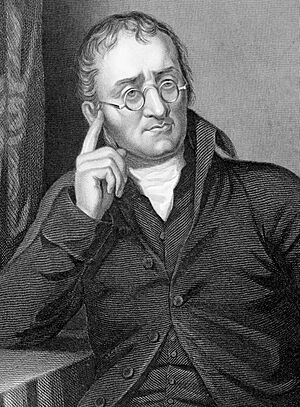Avogadro's law facts for kids
Avogadro's law is a gas law in chemistry that states "equal volumes of all gases, at the same temperature and pressure, have the same number of molecules". This means that if two gases have the same volume and pressure, and temperature, they will have the same number of molecules.
This amazing rule helps scientists understand how gases behave. It tells us that if you have two different gases, like oxygen and helium, and they are in containers of the same size, at the same temperature, and pushing with the same pressure, then they will have the exact same number of tiny particles (molecules) inside them. It doesn't matter what kind of gas it is!
Contents
What is Avogadro's Law?
Avogadro's Law is a fundamental principle in chemistry that helps us understand how gases work. Imagine you have two balloons, one filled with helium and the other with air. If both balloons are the same size, are at the same temperature (like room temperature), and have the same pressure inside, then Avogadro's Law tells us they contain the same number of gas particles.
This law is named after an Italian scientist, Amedeo Avogadro, who first thought of this idea in 1811. It's a very important concept because it links the amount of a gas (how many molecules it has) to its volume, temperature, and pressure.
How Does Avogadro's Law Work?
The law can be written as a simple formula: V/n = k.
- V stands for the volume of the gas (how much space it takes up).
- n stands for the number of moles of the gas (which is a way to count the number of molecules).
- k is a constant number, which means it stays the same as long as the temperature and pressure don't change.
So, if you increase the number of gas molecules (n) in a container, the volume (V) will also increase, as long as the temperature and pressure stay the same. Think about blowing up a balloon: as you add more air (more molecules), the balloon gets bigger (its volume increases).
Who Was Amedeo Avogadro?
Lorenzo Romano Amedeo Carlo Avogadro, Count of Quaregna and Cerreto, was an Italian scientist. He was born in Turin, Italy, on August 9, 1776. He was a professor of physics at the University of Turin.
Avogadro proposed his famous hypothesis (which later became a law) in 1811. However, his ideas were not widely accepted by other scientists for many years. It wasn't until after his death that his work was fully recognized and understood, thanks to another Italian chemist, Stanislao Cannizzaro.
Why is Avogadro's Law Important?
Avogadro's Law is super important for several reasons:
- Understanding Gases: It helps scientists predict how gases will behave under different conditions.
- Chemical Reactions: It's crucial for understanding chemical reactions involving gases. For example, it helps chemists figure out how much of one gas is needed to react completely with another gas.
- Avogadro's Number: This law led to the concept of "Avogadro's Number," which is about 6.022 x 10^23. This huge number represents the number of particles (atoms or molecules) in one "mole" of any substance. It's like a chemist's dozen!
This law is a cornerstone of modern chemistry and is taught to every student learning about gases and chemical reactions.
See also
 In Spanish: Ley de Avogadro para niños
In Spanish: Ley de Avogadro para niños


